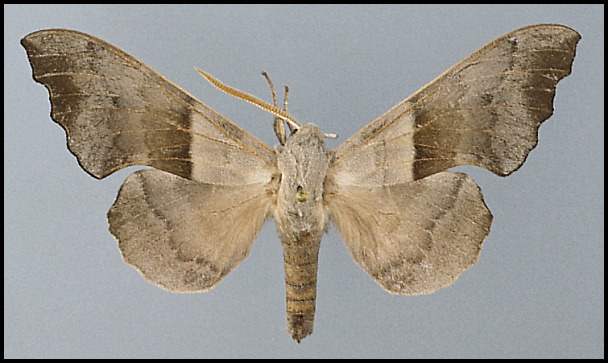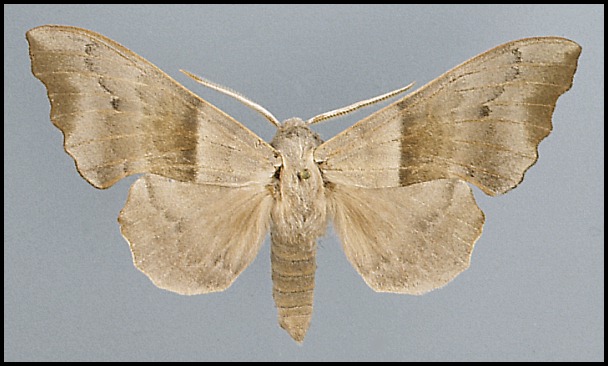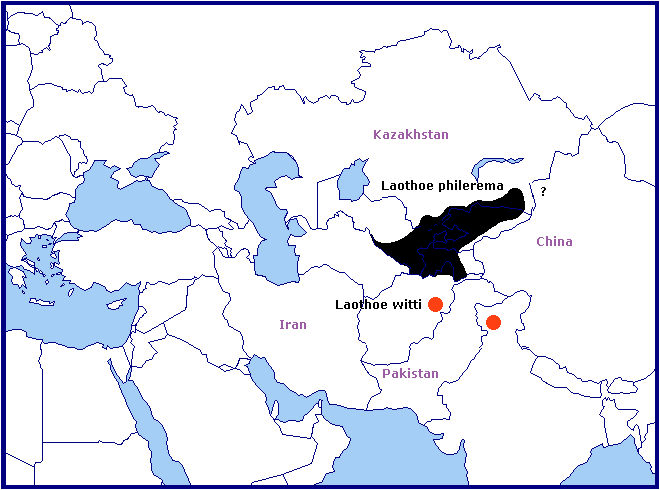UK: Pamir Poplar Hawkmoth; Turanga Sphinx, RUS: Turangovyi Brazhnik
Amorpha populi philerema Djakonov, 1923, Ann. Mus. zool. Acad. Sci. Russ., Petrograd 24: 104--115, pl. 4.Type locality: Termez, near Bukhara [Amu-Dar'ya River, southern Uzbekistan].
(Taxonomic note. Gehlen (1932b) stated that this species is allied to or is even a subspecies of Laothoe amurensis (Staudinger, 1892), basing his conclusions on the lack of a rust-red hindwing patch in both species; however, examination of the male genitalia shows them to be very different from those of Laothoe amurensis and that there is a closer relationship between Laothoe philerema and Laothoe populi (Linnaeus, 1758). D'Abrera (1986) does not illustrate this species.)
Holarctic; western Palaearctic region. Pleistocene refuge: Monocentric -- Turkestan refuge.


Wingspan: 80--120mm. Resembles a very pale, poorly marked Laothoe populi populi, but with the rust-red hindwing patch of that species vestigial or absent -- the two species are easily confused when at rest. The male antennae of Laothoe philerema are unusually long, being half the length of the forewing, which itself bears a distinct antemedial band. In the male genitalia, the two apical processes of the sacculus are even more reduced than in Laothoe populeti (Bienert, [1870]), although similar in outline; the phallus is more slender, less elbowed and with fewer and smaller cornuti at the edge of the vesica.
Very little is known except that it is an inhabitant of river valleys and lake margins in the Hindu Kush and Pamirs. In Kazakhstan, only one habitat is known for certain - the floodplain of the Ili River near the Kapchagay reservoir. Toropov, Milko, Zhdanko & Evdoshenko (2023) state - "Streamside poplar (Populus pruinosa) and poplar-oleaster [Populus-Elaeagnus] forests in sandy desert zone, up to 500m a. s. l.".
Bivoltine, or possibly trivoltine. Adults have been captured in March/April/May and late June to August/September.
OVUM: As Laothoe populi populi, but 2.42mm in diameter.
LARVA: Undescribed. Full-fed 65--75mm.
Hostplants. Populus spp. of the subgenus Turanga (Derzhavets, 1984), such as the desertic Populus euphratica. Danner, Eitschberger & Surholt (1998) state that Populus pruinosa is the only host, as do Toropov, Milko, Zhdanko & Evdoshenko (2023).
PUPA: Undescribed. The overwintering stage (Toropov, Milko, Zhdanko & Evdoshenko, 2023).
None recorded.
Known from eastern Turkmenistan (one specimen in NHMUK coll.), the Ili River floodplain of southern Kazakhstan near the Kapchagay/Qapshaghay Bogeni Reservoir (Serge Yevdoshenko, pers. comm. 2016; Toropov, Milko, Zhdanko & Evdoshenko, 2023), southern Uzbekistan as far west as Kyzylrabat (Eduardo Marabuto, iNaturalist 2021; Djakonov, 1923) and the Tigrovaya Balka Reserve in southern Tajikistan (Derzhavets, 1984; Toropov, Milko, Zhdanko & Evdoshenko, 2023).
The morphologically similar but larger taxon described from eastern Afghanistan is now regarded as a distinct species, namely Laothoe witti Eitschberger, Danner & Surholt, 1998.
Extra-limital range. Unknown, but it probably occurs over most of Kyrgyzstan, north-western China (Ili/Yili River floodplain), northern Pakistan (Hindu Kush) and most of the rest of the Tian Shan range.

 Return to species list
Return to species list